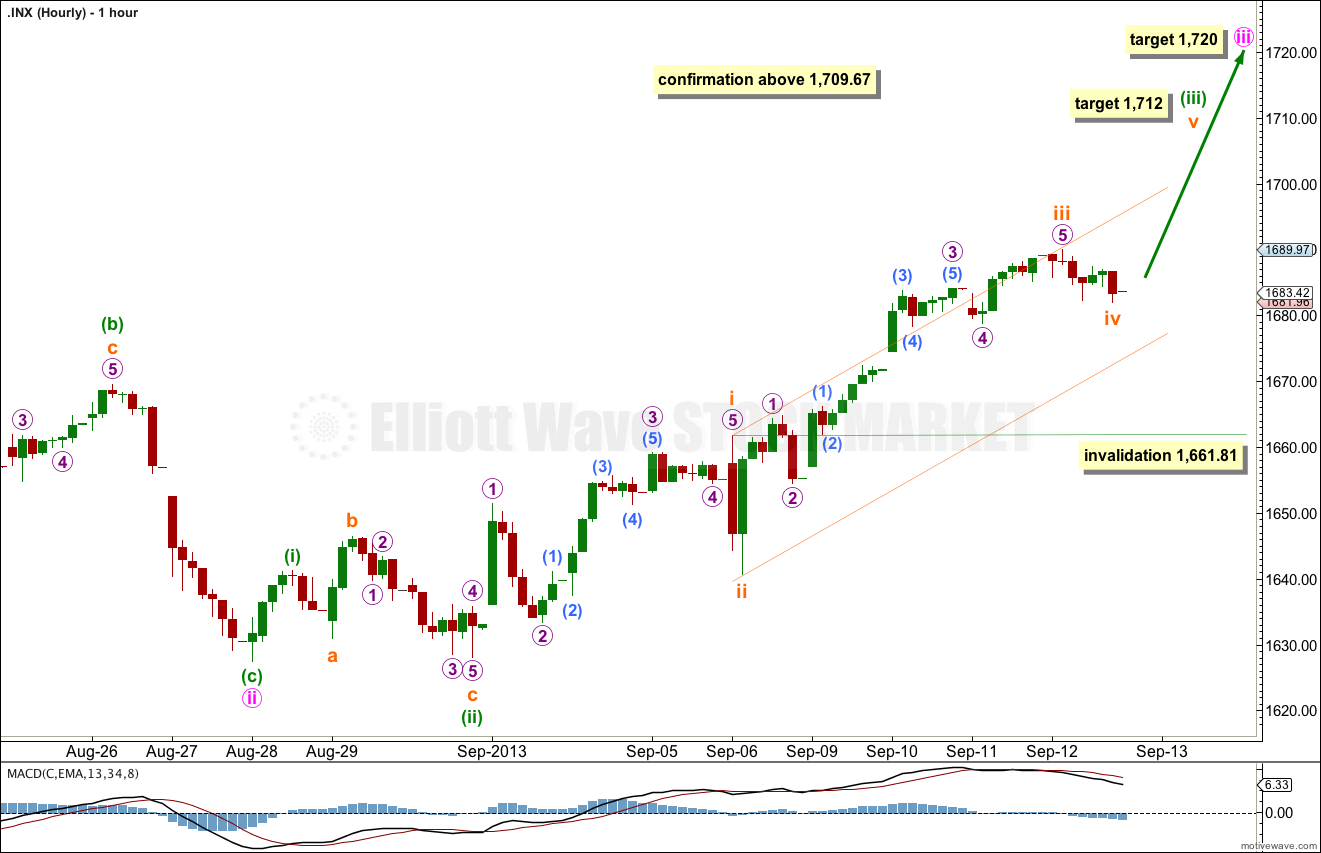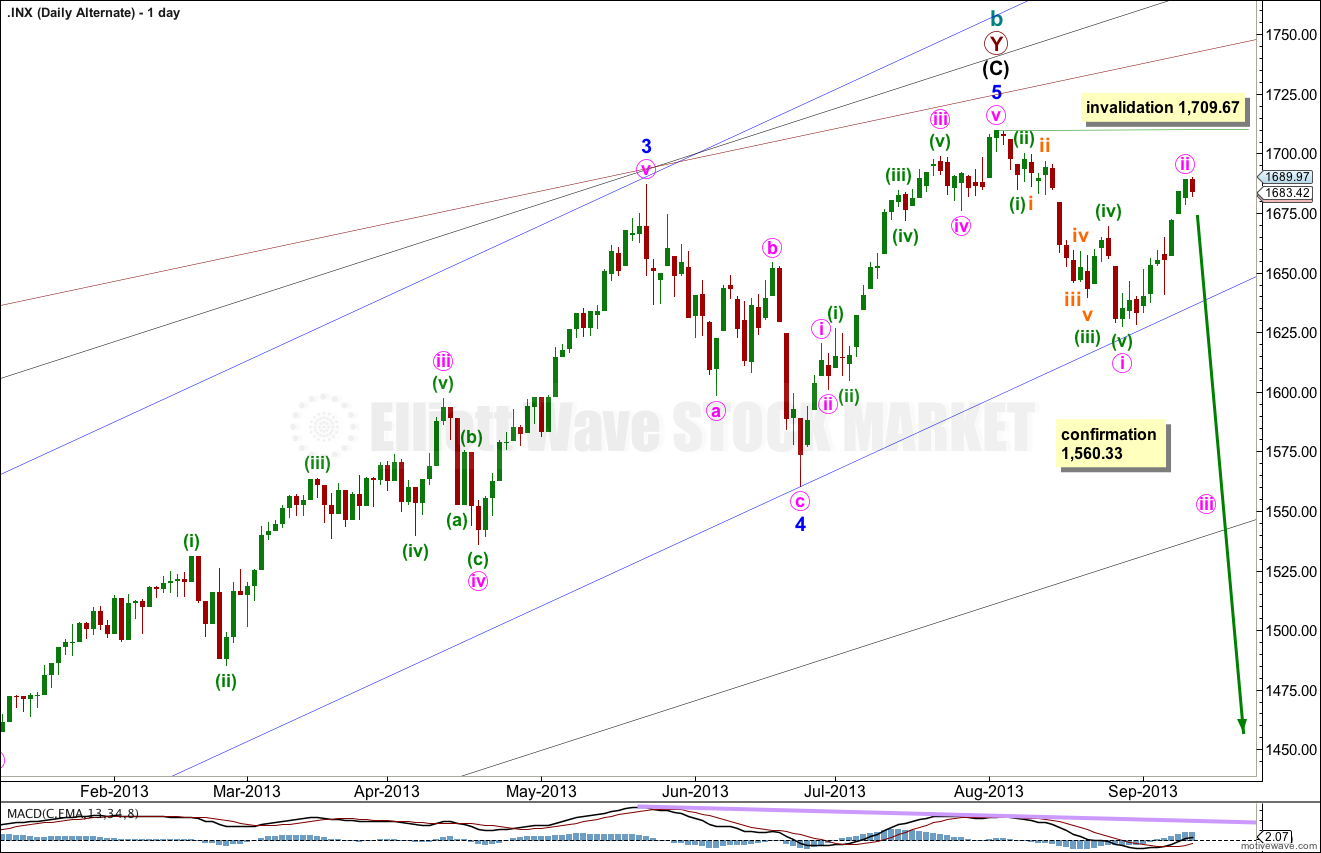Yesterday’s analysis expected more upwards movement to a target at 1,695 to 1,697 before a small fourth wave correction began. Price moved only marginally higher, falling 5.03 points short of the target before the fourth wave began.
The wave count remains the same.
Click on the charts below to enlarge.
Main Wave Count.
This wave count agrees with MACD and has some nice Fibonacci ratios in price and Fibonacci relationships in time.
Minor wave 3 is 15.1 points longer than 2.618 the length of minor wave 1.
Ratios within minor wave 3 are: there is no Fibonacci ratio between minute waves iii and i, and minute wave v is 5.44 points longer than equality with minute wave iii.
At 1,740 intermediate wave (C) would reach equality with intermediate wave (A). At 1,739 minor wave 5 would reach 0.618 the length of minor wave 3.
Within minor wave 5 minute wave ii may not move beyond the start of minute wave i. This wave count is invalidated with movement below 1,560.33.
Minor wave 1 lasted a Fibonacci 21 days, minor wave 2 lasted a Fibonacci 8 days, minor wave 3 has no Fibonacci duration at 98 days, and minor wave 4 lasted 22 days, just one day longer than a Fibonacci 21.
Minor wave 5 may not exhibit a Fibonacci time relationship. The next possibility may be the 29th of October (give or take two days either side of this date) where minor wave 5 would have lasted a Fibonacci 89 days.
Keep drawing the wider parallel channels from the monthly chart and copy them over to the daily chart.
Subminuette wave iii ended earlier than expected, and it has no Fibonacci ratio to subminuette wave i. This makes it more likely we shall see a Fibonacci ratio for subminuette wave v to either of iii or i. At 1,712 subminuette wave v would reach 0.618 the length of subminuette wave iii. If subminuette wave iv moves lower this target must move correspondingly lower also.
Ratios within subminuette wave iii are: micro wave 3 has no Fibonacci ratio to micro wave 1, and micro wave 5 is just 0.05 points short of 0.382 the length of micro wave 3.
Subminuette wave ii was a relatively deep 63% zigzag correction of subminuette wave i. Given the guideline of alternation subminuette wave iv should be a relatively shallow flat, triangle or combination. So far it looks like it is a completed zigzag, and very shallow. It is now within the price range of the fourth wave of one lesser degree; micro wave 4 price range is 1,684.09 to 1,678.70. It may be over here, or this may only be wave A of subminuette wave iv as a flat correction.
If subminuette wave iv continues further I would expect only sideways movement, with only a very slight new low below 1,681.96. If it does continue further it should find support at the lower edge of the parallel channel drawn about minuette wave (iii).
Draw this channel from the highs of subminuette waves i to iii, place a parallel copy upon the low of subminuette wave ii. Expect subminuette wave v to most likely end mid way within the channel, less likely about the upper edge.
Subminuette wave iv may not move back into subminuette wave i price territory. This wave count is invalidated with movement below 1,661.81.
Alternate Wave Count.
While price remains below 1,709.67 it will remain possible that we have recently seen a trend change at cycle degree. However, we should always assume the trend remains the same until proven otherwise.
This is a huge trend change. The new downwards trend should last from one to several years and take price substantially below 666.76. We need some confirmation before having confidence in this wave count.
We should assume the trend is upwards until this wave count is confirmed with movement below 1,560.33, and then with a breach of the black parallel channel on the daily chart.
This wave count is the same as the main wave count, except the degree of labeling in the final upwards wave of minor wave 5 is moved up one degree.
This alternate also expects upwards movement tomorrow.
At 1,703 subminuette wave v would reach 0.618 the length of subminuette wave i. Minuette waves (a) and (c) would not have a Fibonacci ratio to each other, which is common, and minuette wave (c) is excessively long in relation to minuette wave (a) which gives this wave count a very strange look, lowering the probability.
Minute wave ii may not move beyond the start of minute wave i. This wave count is invalidated with movement above 1,709.67.




